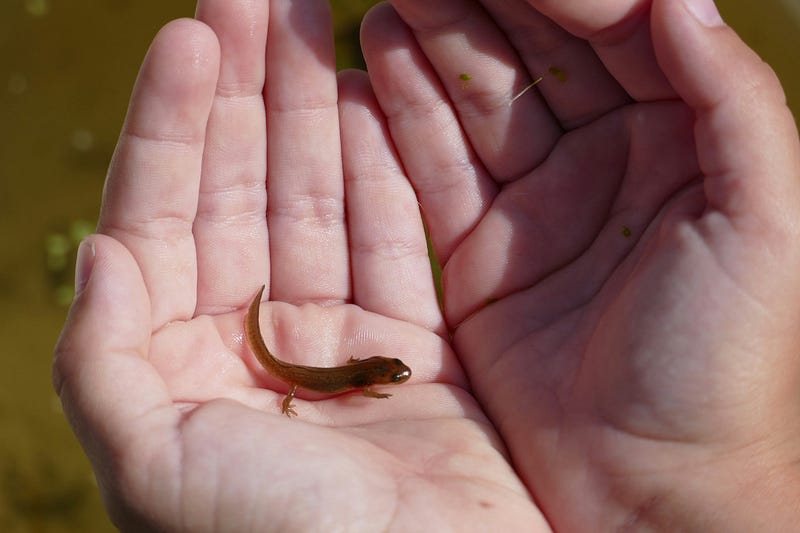Killing Newts for Human Progress: A Reflection on Nature's Loss
Written on
Chapter 1: The Delicate Balance of Nature
In recent weeks, as we near the completion of our home, we have discovered at least three deceased newts. These rough-skinned newts are precious and rare, particularly in damp woodlands where we hope they can thrive alongside us in harmony.
Singing newt songs and laying hundreds of eggs, they weave through life, moving gracefully like tiny alligators in the water, connecting the wetlands to the drier areas filled with birds, insects, and plants.
(More amazing facts about amphibians will follow after our somber narrative.)
The first newt we encountered was across the street at a neighbor’s property. Sadly, the incessant flow of delivery trucks and traffic claimed her life. She might have been attempting to cross from a dwindling pond nearby. It's hard to say.
During this time of year, we often see signs of newts trying to navigate the roads, likely driven from their marshy homes due to rampant development. Over the past four years, countless new human residences have sprung up, wreaking havoc on the remaining woodlands.
The second unfortunate newt met its fate a few blocks away, where new neighbors are clearing land for construction. This poor creature fell onto the cold asphalt, its body contorted and bruised, reminiscent of a tiny, tragic Cthulhu figure.
We paused for a moment of mourning, yet our thoughts continue to dwell on these newts. We hope you too will reflect on the plight of amphibians.
Murder in Our Own Backyard
Just yesterday, while moving the last pile of rocks from our front yard, I stumbled upon another tragic victim. Our contractor, while using a backhoe, inadvertently unearthed yet another lifeless rough-skinned newt.
The weight of guilt was heavy on my heart as a property owner. In a world filled with issues that provoke guilt, we often feel powerless to change our modern ways, especially when it comes to construction that displaces wildlife we wish to coexist with.
I urged the backhoe operator to move to a different area, declaring, "NO! The natural patch must remain on this side of the fence."
His puzzled expression contrasted with my husband's understanding gaze. We resolved to prevent further habitat destruction and unnecessary loss of snake and amphibian lives.
Conserving What We Can, Including Humans
One reason my husband grasps this issue so deeply is our weekly dedication to rescuing ladybug beetles trapped indoors. I also save cornered spiders and other insects. However, I felt helpless in saving the rough-skinned newts. As an endangered species, these salamanders are remarkable; they breathe through lungs like we do and thrive in both land and aquatic environments. They inhabit deep, decaying logs and brush piles—never burn those brush piles, even while building a new home. They are carnivorous and toxic, so please refrain from licking them or, like that unfortunate man in Oregon, swallowing one on a dare.
Instead of "draining the swamp," we ought to move heaven and earth—without heavy machinery—to protect these amphibians.
The newt's genome is ten times larger and more varied than that of humans. They possess the incredible ability to regenerate limbs, tissues, heart muscle, and even eye lenses.
Unlike us, even with advancements in AI and space exploration, we cannot regenerate human tissues. Furthermore, we cannot hunt for food just above the ground using only our mouths and lively movements.
Speaking of movements, newts perform stunning mating dances and share a unique form of kissing, reinforcing the idea that nature has always understood love and attraction.
During the late Carboniferous period, amphibians like newts could grow to fifteen feet long, dominating the forests for tens of millions of years—far longer than our species is likely to endure.
Human Progress and Its Consequences
We must complete our home and continue as though the world isn't facing significant challenges. We live on as if we aren't contributing to the problem.
While I may not understand newt psychology, human behavior tends to be predictable. Few people seem to realize the impact of their encroachment on natural habitats.
If you've experienced construction, you know it can be a wasteful and chaotic process. We often treat the Earth as if we can abandon it without consequence.
I hope that with whatever time we have left, you and I can learn from the magical newt, gaining insights into how to coexist with nature. They require little and thrive with much less than we do, yet they possess profound wisdom about the ecosystems from which they emerged. They have much to teach us.
Please clap, follow, highlight, or comment to show your appreciation for the rivers of knowledge shared here.
Section 1.1: The Impact of Human Development

Section 1.2: The Importance of Conservation
Chapter 2: Understanding the Poisonous Nature of Newts
The first video, "Poisonous NEWT can be DEADLY!" discusses the toxicity of newts and how it impacts their survival and interactions with humans.
The second video, "Extremely Poisonous Newt!" explores the dangers posed by these amphibians and the importance of respecting their habitat and existence.